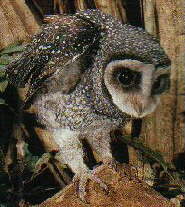|
LESSER SOOTY OWL

Photo: C & D Frith
Wet Tropics Rainforest Life

LESSER SOOTY OWL
Tyto multipunctata Male 33 cm, Female 37 cm
·
The Lesser Sooty Owl is endemic to the Wet Tropics
region.
·
Part
of the "masked" group of owls.
· Lesser Sooty Owls, like all other owls, are known as raptors, or birds of prey.
They are unrelated to diurnal species of raptors, but similar in habit. Because they are
predators, they are valuable components in ecosystems.
·
It was once thought that all sooty owls comprised only one species in
three
distinct populations, but they have now been given a separate species status. Those living
in the Wet Tropics (Atherton population) have been named the Lesser Sooty
Owl, and those
in the south-east Australia and New Guinea, the Sooty Owl. The indigenous name is durrguu.
·
They live throughout the rainforest, roosting in tree crevices and in spaces
between the aerial roots of figs and overhanging banks. Members of a pair maintain a bond
but do not roost together.
·
They feed predominantly on terrestrial animals (eg. rats, bandicoots and other
rodents), but also on arboreal (tree-dwelling) ones (eg. possums, birds and gliders).
As they are at the top of the food chain however, they can be limited
by the availability of their prey. They are also vulnerable to human impact.
·
They are sedentary (do not travel far) and territorial. They are generally long
lived, have low reproduction rates and low population densities. The breeding season is
from January to August.
·
Despite their restricted
range, they are classed as common. Since white settlement, the total population size is
believed to be unchanged (stable). This contrasts to the Sooty Owl, which is common, but
decreasing in numbers (largely due to clearing).
·
There are known to be two mating pairs in the Lake Eacham region, where they are
commonly seen at night, and heard making their characteristic high-pitched ‘falling
bomb’ call. This is a loud descending screech, sounding like a
whistling note when heard distantly.
· Lesser Sooty Owls, when
threatened, make clicking sounds with their tongues to intimidate predators. (Source:
Environmental Protection Agency)
·
They have large black eyes, spotted upperparts, white-grey underparts, a dark
grey breast and reversible outer toes to perch with two toes forward and two toes
backward. They have a crouched posture.
·
These owls regurgitate pellets containing the less digestible components of their
prey (eg. hair, scales, bone and invertebrate exoskeletons). The acidity of the digestive
system determines the consistency of these elements.
·
Raptors may suffer from secondary poisoning from the accumulation of pesticides,
and are known to be more sensitive to the effects of DDT (dichlor-diphenyl-trichlor-ethane).
·
As the Lesser Sooty Owl is unable to build a true nest and depends on nest
hollows, it is especially vulnerable to habitat loss. The most significant raptor
conservation problem is the destruction, degradation and alteration of habitat.
·
Owls, like many nocturnal animals, have good night vision, but rely also on their excellent hearing - up to four times better than any other animal tested - which allows some to hunt in complete darkness. Because their left and right ears are placed at different levels on their heads there is a slight difference in the time taken for a particular sound to reach each ear. This time-lag enables the owl to pinpoint the source of the sound more accurately. The higher ear has an opening facing downwards and is more sensitive to sounds from below. Feathers within the characteristic facial disc are positioned so as to funnel sound to the ears. Stiff feathers bordering the ear slits are attached to moveable flaps so an owl can change the shape of its ear opening and focus its hearing.
· When swooping on its
prey on of the owl's outer toes can be brought around so the four talons grip
from four different directions. Large amounts of indigestible fur, feathers and
bones are swallowed but once or twice a day these items are regurgitated, in
tightly-packed pellets. Researchers can often learn a lot about animals living
in a particular area by examining these pellets; bones of the rarely-trapped
prehensile-tailed rat are the only indication that it is more common than
sightings would suggest. (Source: Department of Environment)
·
Masked owls, which have a more silent flight,
huge ears and better hearing, hunt by patrolling their territory on the wing and
pouncing, after which the prey is carried in the beak and usually swallowed
whole.
(Source: Department of Environment)
·
Power poles can be hazardous for medium to large birds too. If they touch two
electrical wires at the same time, or a single-phase and a ground wire, they will be
electrocuted. All sized owls may be at risk from pole-top transformers. To reduce risk,
the insulation of closely spaced wires and the provision of safe perches are efficient and
cost effective methods. It is also likely that the bird may be injured or killed from
colliding with the electrical wires or structures.
·
While feeding on road-killed animals, many owls themselves are killed by
vehicles. Removing these animals from the roads would help reduce this problem.
·
Since 1971, the Lesser Sooty Owl and all other Australian raptors have been
protected by legislation. The only legal trade of these birds is between registered
wildlife and zoological gardens.
RETURN
TO BIRD INDEX
| 